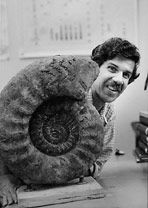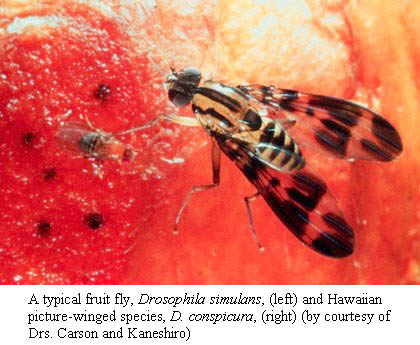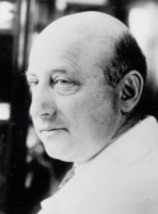 Featured
Scientist: Stephen Jay Gould
Featured
Scientist: Stephen Jay Gouldsource of image
Notes for Understanding Evolution - Chapter 19
Click link to return to Biology
409 Schedule
or back to Chapter 18
or ahead to Chapter 20
General guide on these review questions here
Notes for Chapter 19: Microevolution, Macroevolution, and Punctuated Equilibrium
Introduction
 Featured
Scientist: Stephen Jay Gould
Featured
Scientist: Stephen Jay Gould
source
of image
Links: 1 - 2 - 3 - 4 - 5 - 6 - 7 - 8 - 9 - 10 - 11 - 12 - 13 - 14
RQ19.1: Explain briefly what is meant by the phrase coined by Stephen Jay Gould and Niles Eldridge as "punctuated equilibrium."
I. Rapid Evolution in Animal Species
Featured Organisms: Hawaiian Drosophilidae

source
of image
Links: 1 - 2 - 3 - 4 - 5 - 6 - 7 (pdf) - 8 (pdf) - 9 (pdf) - 10 - 11 - 12
PBS Link (see Species Gallery - Hawaiian fruit flies)
RQ19.2: What is the evidence for rapid speciation of drosophilid flies on the big Hawaiian island, Hawaii?
II. The Founder Principle and Rapid Diversity
RQ19.3: How is the special case of Sewall Wright's notion of genetic drift called the Founder principle likely to be related to the "punctuated" emergence of new species in the fossil record? In other words, why is it not too surprising that new species suddenly appear in the fossil record with little evidence of gradual change from their closest relatives?
III. Tenet of Punctuated Equilibria
RQ19.4: Contrast the notions of phyletic gradualism and punctuated equilibrium in somewhat greater detail than above in the first review question, providing at least one example.
IV. "Hopeful Monster"
 Featured
Scientist: Richard Goldschmidt
Featured
Scientist: Richard Goldschmidt
source
of image
Great example: Antennapedia mutation in Drosophila causes legs to grow where antennae normally are. Today we understand how a relatively minor mutation (in this case, to a "regulatory" gene whose protein product regulates an entire cascade of other proteins) can drastically affect development, even creating a "hopeful monster" of the sort that Goldschmidt might have envisioned.
Wow! Link 3 above contains quotes from what Goldschmidt really said. If you want to see how creationists have distorted Goldschmidt's notion, do a google search for "Goldschmidt hopeful monster" or something along these lines. This is too bad because Goldschmidt was an excellent writer and thoughtful scientist. If you doubt this, I highly recommend that you read his biography, The Golden Age of Zoology, which apparently is still available. This is an illuminating and very readable account of why Germany was such a great place for classical zoology around the turn of the century.
RQ19.5: Why does the discovery of mutations to homeotic genes that regulate other genes, such as antennapedia in Drosophila, provide a mechanism where a simple base substitution (i.e., a microevolutionary event) can drastically affect the development of an animal, that we might then perceive as a macromutation?
V. Evolution of Horses
The evolution of horses is one of the most widely used examples of evolution
but is also among the most misunderstood, and biology textbooks are often to
blame. For this reason, please carefully read the following supplementary material
on horse evolution before attempting to answer the review question.
Horses have one one of the better fossil records for any large terrestrial vertebrate,
and were among the first carefully considered examples that were considered
as strong support for Darwin's notion of gradual evolution through transitional
stages. Textbooks tend to make the mistake of presenting horse evolution in
a linear "ladder-like" series, from small to large, from three toes
to one, from small generalized teeth to large grass-crushing teeth (grasses
are essentially protected with glass fibers and grasses had not evolved yet
when the first horses evolved). Look at Figure 19.3 and you will see that our
text is partly guilty in this regard. They superimpose "the ladder"
on an otherwise fairly bushy diagram of horse evolution. Part of the problem
is that horses are a group that has only a few surviving species, all in one
lineage, so that it is natural for us to think of this ladder-like progression
from simple to complex. Instead, when the detailed fossil record is studied,
one learns that it was a big bush, not a ladder, with only one surviving "twig"
today. At the peak of horse diversity, there were both big and small horse species,
and one-toed horses coexisted with multi-toed horses for millions of years.
There is an excellent display of the changing views of horse evolution at the
American Museum of Natural History, which I visited recently. Here is part of
the display from a photo I took then.

Note the two smallest horses from early in the history of horse evolution in
the lower right. These include the famous Hyracotherium (also known as
eohippus, which means "Dawn Horse") from the early Eocene. (The Eocene
lasted from 55 to 34 MYBP = million years before present). Directly behind these
small early horses are two horses from much later, I think in the Miocene (26
to 7 MYBP). The larger horse skeleton is quite complete, but right in front
of it is the skull of what is thought to be an adult of a much smaller species,
not just a juvenile of the larger species. This is but one example (unfortunately,
not a very well-illustrated one) of very different horse species living at the
same time. A more complete account of the fascinating evolution of horses by
Kathleen Hunt can be found here.
To quote from that source:
"Horse species were constantly branching off the "evolutionary tree" and evolving along various unrelated routes. There's no discernable "straight line" of horse evolution. Many horse species were usually present at the same time, with various numbers of toes, adapted to various different diets. In other words, horse evolution had no inherent direction. We only have the impression of straight-line evolution because only one genus happens to still be alive, which deceives some people into thinking that that one genus was somehow the "target" of all the evolution. Instead, that one genus is merely the last surviving branch of a once mighty and sprawling "bush".
Kathleen Hunt also points out that there were no consistent trends:
Tracing a line of descent from Hyracotherium to Equus reveals several apparant trends: reduction of toe number, increase in size of cheek teeth, lengthening of the face, increase in body size. But these trends are not seen in all of the horse lines. On the whole, horses got larger, but some horses (Archeohippus, Calippus) then got smaller again. Many recent horses evolved complex facial pits, and then some of their descendants lost them again. Most of the recent (5-10 My) horses were three-toed, not one-toed, and we see a "trend" to one toe only because all the three-toed lines have recently become extinct.
I also highly recommend reading a popular book entitled simply Horses, written
in 1951 and updated in 1961, by the most famous horse paleontologist, George
Gaylord Simpson. The book might be hard to find but is a great read if you find
one. There is also lots of good information and clarification of misinformation
at the Fossil Horses FAQ website.
The real fossil history of horses is both much more complicated and much more
fascinating than most textbook accounts. You might not have realized that horses
evolved in North America and invaded the Old World over time at least three
separate times, leaving such abundant fossil remains when they did that these
fossils are used as stratigraphic age markers in the Old World. They also invaded
South America when these continents became connected through the action of plate
tectonics, some 3+ million years ago, and the evolution of horses in South America
is an entirely separate and interesting story. Much later, in fact only after
the last Ice Age, about 10,000 years ago, they went completely extinct in North
America, only to be reintroduced by Cortez and the invading Spaniards. The long
fossil record of horses suggests that they were dominant and diverse animals
of North American prairies, analogous to the diverse antelopes that live in
the African savannah today. We do have countless examples of this history of
horse through time in North America, but the appearance of "modern"
horse features such as the one-toed hoof was often quite "sudden"
in geological terms.
There is another classic example in biology textbooks (hint: see Chapter 17
or this link
or the PBS lesson here)
for a case where a group of animals that is restricted to a single surving species
today, but once had multiple species living simultaneously, even together geographically.
I highly recommend that you seek out the following essay for an insightful account of how the example of the evolution of the horse has been repeated uncritically since it first emerged in 1851, even though the notion that there were "directed" linear trends (orthogenetic series) has been obsolete for some 70 years:
Prothero and Schoch, 1994. Mammalian evolution, pp. 238-270 in Major Features of Vertebrate Evolution. Short Courses in Paleontology No. 7, The Paleontological Society.
One point that the authors make is that by choosing a group that has only a few surviving species, one automatically tends to mislead students into thinking of evolution in terms of linear series. When we now know lots about a variety of mammal groups that include diverse living species (e.g., antelopes, bats, rodents), perhaps we should start emphasizing some of these groups instead.
For an excellent on-line introduction to evolution and the fossil record suitable for students, see here.
RQ19.6: In what way does the actual evolutionary history of horses conflict with the presentations of linear series of "trends" of horse evolution (e.g., size increase, toe reduction, tooth modification) typically found in introductory biology texts?
VI. Modes of Human Evolution
RQ19.7: Contrast in words what changes when
hominid phylogeny is "expressed by the controvertible theory of punctuated
equilibria" (UE Fig. 19.4 caption) versus the more conventional view of
human evolution, exemplified one of these sorts of diagrams:
Click link to return to Biology
409 Schedule
or back to Chapter 18
or ahead to Chapter 20
This page created 6/8/02 © D.J. Eernisse, Last Modified 4/8/03, Links Last Completely Checked 4/7/03